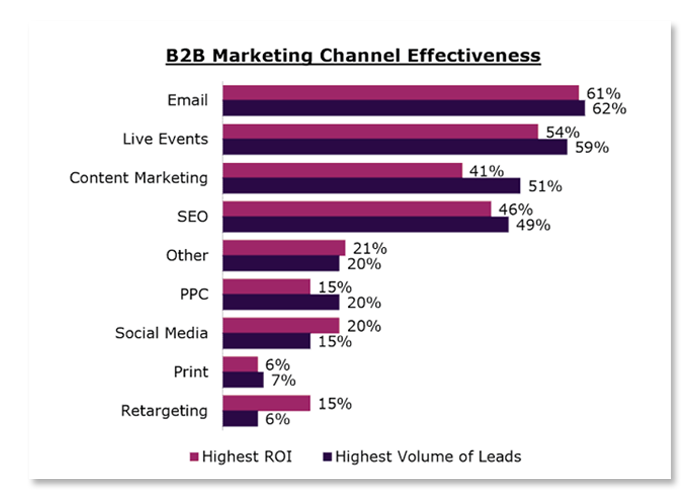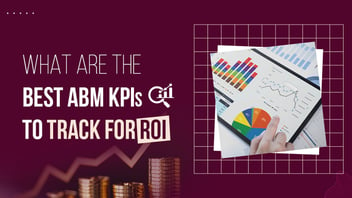
Top 10 Lead Generation Sales Metrics You Should Not Miss
Whichever sales lead generation method you pursue, you need to track it. That's the way to know how effectively these methods work for your business. This is where lead generation sales metrics come into play.
These metrics help you determine the effectiveness and ROI of your sales lead generation campaigns. Thus, you can make data-driven decisions to improve your lead generation strategies.
Let us first walk you through metrics indicators and tactics to track your lead generation efforts.
What Are KPIs In Lead Generation Sales Metrics?
The main sales KPIs include sales activity metrics and sales-readiness.
Sales activity metrics are a track record of:- Daily or weekly number of calls made.
- Daily or weekly number of emails sent.
- Overall connections number with the completed target.
- The number of scheduled meetings.
These metrics help you learn how many leads and calls your sales team needs to make within a defined period. Knowing the required number helps ensure ideal deal numbers are present in the pipeline.
Furthermore, the sales readiness metric measures your SDRs' capabilities, such as:- Confidence
- Product Knowledge
- Mastery in delivering your value messaging
- Playbooks
- Training sessions
- Certification programs
- Sales Coaching
Top 10 Lead Generation Sales Metrics To Track
The 10 best B2B lead generation sales metrics examples to focus on are:
1. SQLs Generated
41% of marketers say quality lead generation is a great challenge for them. Thus, it is important to understand whether your lead generation efforts are reaching the right leads.
Use this metric for a performance overview of your lead generation activities. If most of your MQLs aren't converting to SQLs, there's a problem in your sales process.
Know where exactly in the sales funnel your leads are dropping off. Further, make needed improvements, then review the results again.
2. MQL To SQL Conversion Rate
It gives an immediate understanding of the performance of your lead generation system for SQL conversion. The low conversion rate could be due to the following:
- Your marketing campaign is incapable of getting responses from your target market.
- Your Account Executive (AE) team is struggling to convert leads into customers.
How AEs Can Boost Their Sales Closing Rate
Thus, it is time to assess these areas and focus on improving your conversion rates.
This metric helps manage and measure the handover from the marketing team to the sales team.
3. Month-To-Date (MTD) Goal
MTD sales goal is the total sales target your business aims to achieve from the current month's beginning date to the present day. It's usually set at the start of each month. It tracks the sales team's progress toward achieving its monthly target.
Formula: Target revenue for the entire month/ The number of days in that month
For example, let’s say you have $100,000 as your monthly sales goal. There are 30 days in the month, so the MTD sales goal/day would be $3,333.33 ($100,000/30).
Once the MTD sales goal is set, you can proceed to:
- Track the sales team's daily progress.
- Make necessary adjustments to sales strategies.
- Identify potential issues or opportunities. Take action to stay on track to achieve their overall sales targets.
4. Time Spent To Convert
It is one of the important B2B lead generation KPIs that helps identify obstacles in quick lead conversion. Here are two methods to track this metric:
- Lead-to-customer Conversion Time:
It measures the time it takes for a lead to become a paying customer. It starts from the time a lead is generated to the time they make their first purchase.
The shorter the conversion time, the faster the leads turn into paying customers. It also helps identify bottlenecks in the sales process and allows you to take steps on time to address them. - Sales cycle length:
It measures the time it takes to close a sale from the first contact with a lead to the moment they make a purchase.
A shortened sales cycle accelerates the speed at which leads convert. You can do it by:
- Identifying and addressing common objections.
- Improving the quality of your sales messaging.
- Streamlining your sales process.
5. Capture Vs. Conversion Rate
Stats say that 79% of leads don't convert into sales. It means all newly captured website visitors who provide some form of contact or personal information will not necessarily convert.
Thus, use this metric to evaluate how well the capture rate aligns with the ultimate conversion rate. Here’s the formula to calculate it:
Lead conversion rate = The total number of leads / The total number of sessions*100.
6. Email Marketing Performance
Every business recognizes the significance of having an email marketing strategy. However, depending on the goals of each campaign, such as lead generation or subscriber base expansion, each email marketing campaign may differ.
However, there is certain fundamental lead analytics that you should monitor, such as:
- Open rate: A report suggests 43% of prospects open branded emails once a day at minimum. Thus, you must know how well your subscribers are responding to your messages. The open rate monitors the number of subscribers who opened the email you sent.
- Conversion rate: Email conversion happens when a subscriber performs a specific action after they open your email. To calculate the email conversion rate, use the following formula:
(Total number of recipients performing the desired action/ The total number of delivered emails)*100 - List growth rate: It monitors your email list’s growth rate. To calculate it, use the following formula:
((Total number of unsubscribes - Total number of new subscribers)/ The total number of email addresses on your list) X 100. - Forwarding rate: It assesses the recipients’ percentage who shared your post on social sites or forwarded it to their contact. This statistic provides insight into the subscribers’ percentage who are recommending your emails to others.
7. Meetings Booked And Attended
It monitors the number of meetings, marketing prospects book and attend. By tracking the meetings booked, you can measure the leads' quality. Additionally, the number of meetings attended helps you forecast your sales-qualified opportunities (SQOs).
8. Time to Conversion
It's essential to monitor the total time to conversion at every stage of your funnel
to understand the duration of your sales cycle accurately.
Use the following formula:
The total time all your visitors spend before they complete your defined conversion goal / Divide that number by the total number of leads.
Let’s understand it through an example:
Suppose you have these three leads:- Martin takes 9 hours to verify his email address.
- Sam takes 21 hours to verify her email address.
- Josh takes 30 hours to verify his email address.
By applying the formula stated earlier, we can determine the Time to Conversion:
Time to conversion = (9 + 21 + 30)/3) = 20 hours
When customers make a purchase, they want a seamless and straightforward process. However, a lengthy checkout or sales funnel can distract them, ultimately resulting in missed sales opportunities.
Thus, minimizing the touchpoints in your funnel is advisable. It will ultimately reduce your time-to-conversion duration.9. Preferred Main Lead Channels
Find the channels that qualified leads prefer the most. It will help you to:- Optimize your marketing and sales efforts.
- Drive more high-quality leads.
- Maximize your return on investment (ROI).
In fact, 95% of marketers state they are aware of the channels that drive the most leads to their business.
So, here are some common ways to find which lead channels you must focus on:
- Google Analytics: The tool identifies which channels drive the most qualified leads. Assign specific goals to each channel in terms of lead generation and see which ones perform the best. It’ll help measure their effectiveness.
Thus, you can adjust your marketing strategies accordingly. - Customer Relationship Management (CRM) software: It allows you to observe the leads through the entire sales process. Thus, you can see which channels your qualified leads mostly engage with.
- Customer surveys: You can run surveys to determine your customers' preferred channels, from where they discovered your business, etc. You can then optimize those channels as needed.
Some of the common channels include Email marketing (Cold & Warm emailing), content marketing, Live Events, etc. Below is the graph that shows the top-performing channels for sales lead generation:

10. Lead Generation Rate by Channel
The lead generation rate is valuable when running campaigns across multiple channels. It shows a performance overview of each channel.
Here’s the formula you can use:
The total number of captured leads / The total number of visitors who accessed a specific channel.
These channels include Social Media, Paid, Organic (SEO), and Referral.
Furthermore, you can get deeper insights by analyzing each channel’s traffic sources, such as LinkedIn, Facebook, and Twitter.
Assuming that you had 10,000 visitors through social media, and 100 of them converted into leads, your lead generation rate from social media is 1%. Similarly, if you had 2,000 organic visitors, and 100 of them converted into leads, your SEO channel rate is 5% (100/2000 x 100).
It's important to keep in mind that lead generation rates will vary depending on the traffic source. Don’t expect the same conversion rate from Twitter traffic as from a highly targeted paid advertisement. Thus, it's crucial to factor in your traffic acquisition costs when evaluating the performance of any given channel.
Conclusion
Lead generation sales metrics are critical for your B2B businesses. You get valuable insights leading to the success of your lead generation strategies. They help identify areas for improvement and optimize your marketing campaigns for better results. So, optimize and review your lead metrics using the information mentioned above.
We at Revnew, understand that prospecting for new customers/lead generation is time-consuming, expensive, and challenging to track. So we are here to help you out with our robust lead-generation strategies.
Learn how Revnew is helping a new data-first security platform generate 50+ leads in just 6 months.




